AYB311 Financial Accounting Issues Research Report - University
VerifiedAdded on 2022/09/10
|7
|1120
|21
Report
AI Summary
This report delves into critical financial accounting issues, focusing on depreciation methods, earnings management strategies, and the role of corporate governance. The analysis begins by identifying depreciation as a key area for potential misstatements and explores the straight-line method's impact, referencing Blackmores Limited's annual reports to illustrate real-world applications. The report then examines board characteristics essential for business success, such as transparency, accountability, and the skills of board members, using Blackmores as a case study. It also explores executive compensation, discussing the benefits and drawbacks of incorporating non-financial performance indicators. The report concludes with an overview of the importance of earnings in assessing an organization's performance and evaluates common methods of earnings management, highlighting the consequences and the role of corporate governance in mitigating these issues. The report makes references to several sources, including academic literature, and presents a comprehensive overview of the topic.
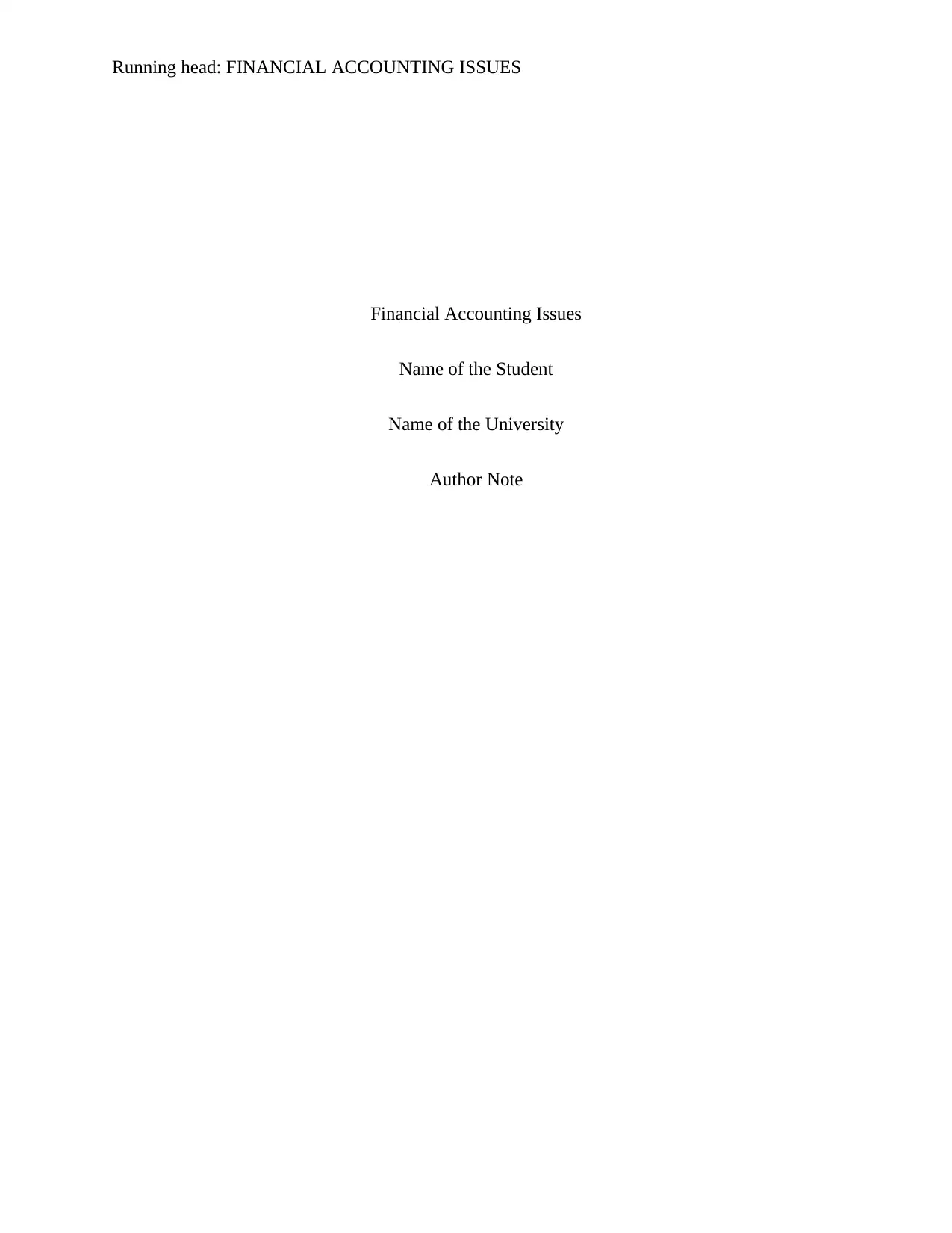
Running head: FINANCIAL ACCOUNTING ISSUES
Financial Accounting Issues
Name of the Student
Name of the University
Author Note
Financial Accounting Issues
Name of the Student
Name of the University
Author Note
Paraphrase This Document
Need a fresh take? Get an instant paraphrase of this document with our AI Paraphraser

1
FINANCIAL ACCOUNTING ISSUES
Table of Contents
Part A...........................................................................................................................................2
References....................................................................................................................................5
FINANCIAL ACCOUNTING ISSUES
Table of Contents
Part A...........................................................................................................................................2
References....................................................................................................................................5
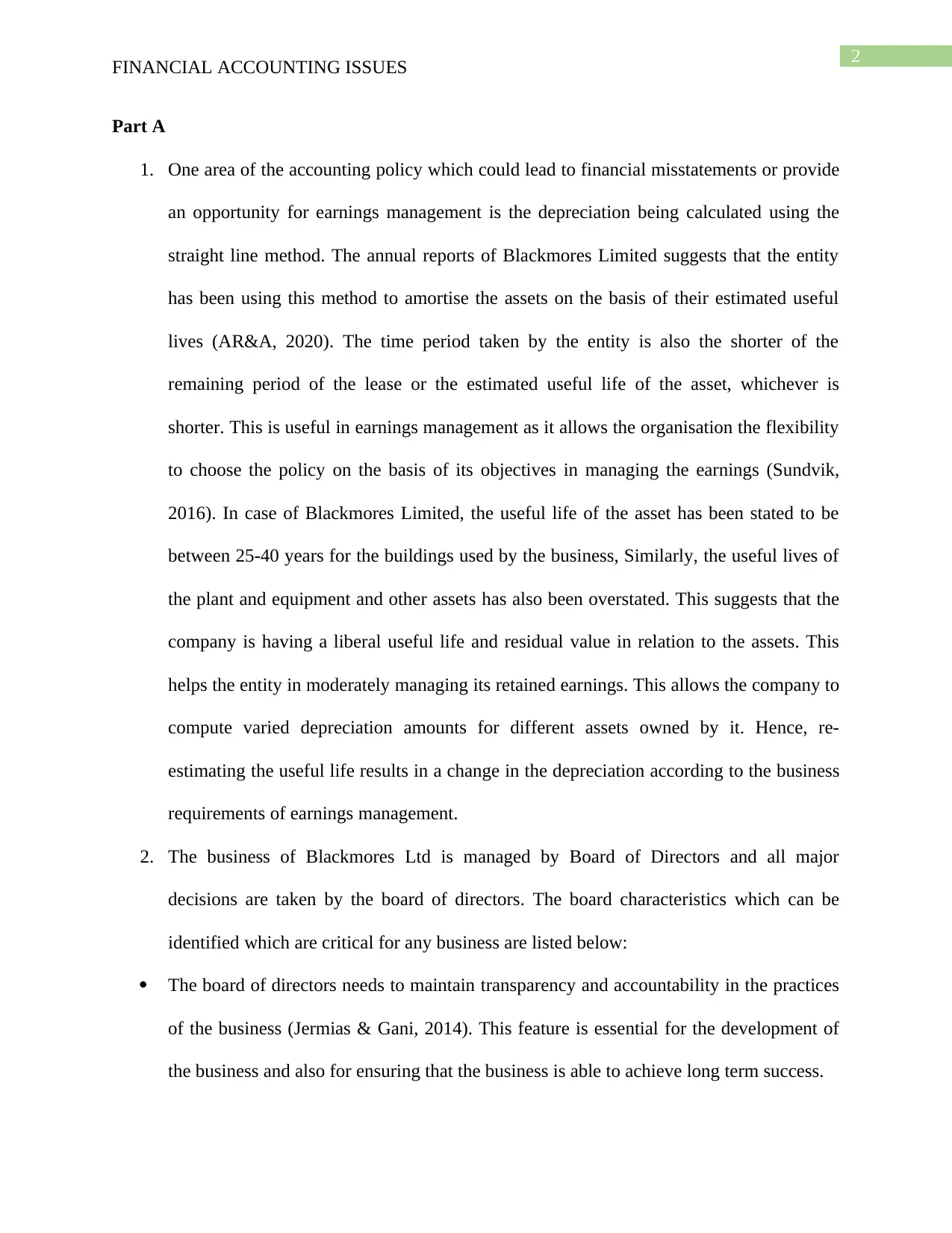
2
FINANCIAL ACCOUNTING ISSUES
Part A
1. One area of the accounting policy which could lead to financial misstatements or provide
an opportunity for earnings management is the depreciation being calculated using the
straight line method. The annual reports of Blackmores Limited suggests that the entity
has been using this method to amortise the assets on the basis of their estimated useful
lives (AR&A, 2020). The time period taken by the entity is also the shorter of the
remaining period of the lease or the estimated useful life of the asset, whichever is
shorter. This is useful in earnings management as it allows the organisation the flexibility
to choose the policy on the basis of its objectives in managing the earnings (Sundvik,
2016). In case of Blackmores Limited, the useful life of the asset has been stated to be
between 25-40 years for the buildings used by the business, Similarly, the useful lives of
the plant and equipment and other assets has also been overstated. This suggests that the
company is having a liberal useful life and residual value in relation to the assets. This
helps the entity in moderately managing its retained earnings. This allows the company to
compute varied depreciation amounts for different assets owned by it. Hence, re-
estimating the useful life results in a change in the depreciation according to the business
requirements of earnings management.
2. The business of Blackmores Ltd is managed by Board of Directors and all major
decisions are taken by the board of directors. The board characteristics which can be
identified which are critical for any business are listed below:
The board of directors needs to maintain transparency and accountability in the practices
of the business (Jermias & Gani, 2014). This feature is essential for the development of
the business and also for ensuring that the business is able to achieve long term success.
FINANCIAL ACCOUNTING ISSUES
Part A
1. One area of the accounting policy which could lead to financial misstatements or provide
an opportunity for earnings management is the depreciation being calculated using the
straight line method. The annual reports of Blackmores Limited suggests that the entity
has been using this method to amortise the assets on the basis of their estimated useful
lives (AR&A, 2020). The time period taken by the entity is also the shorter of the
remaining period of the lease or the estimated useful life of the asset, whichever is
shorter. This is useful in earnings management as it allows the organisation the flexibility
to choose the policy on the basis of its objectives in managing the earnings (Sundvik,
2016). In case of Blackmores Limited, the useful life of the asset has been stated to be
between 25-40 years for the buildings used by the business, Similarly, the useful lives of
the plant and equipment and other assets has also been overstated. This suggests that the
company is having a liberal useful life and residual value in relation to the assets. This
helps the entity in moderately managing its retained earnings. This allows the company to
compute varied depreciation amounts for different assets owned by it. Hence, re-
estimating the useful life results in a change in the depreciation according to the business
requirements of earnings management.
2. The business of Blackmores Ltd is managed by Board of Directors and all major
decisions are taken by the board of directors. The board characteristics which can be
identified which are critical for any business are listed below:
The board of directors needs to maintain transparency and accountability in the practices
of the business (Jermias & Gani, 2014). This feature is essential for the development of
the business and also for ensuring that the business is able to achieve long term success.
⊘ This is a preview!⊘
Do you want full access?
Subscribe today to unlock all pages.

Trusted by 1+ million students worldwide
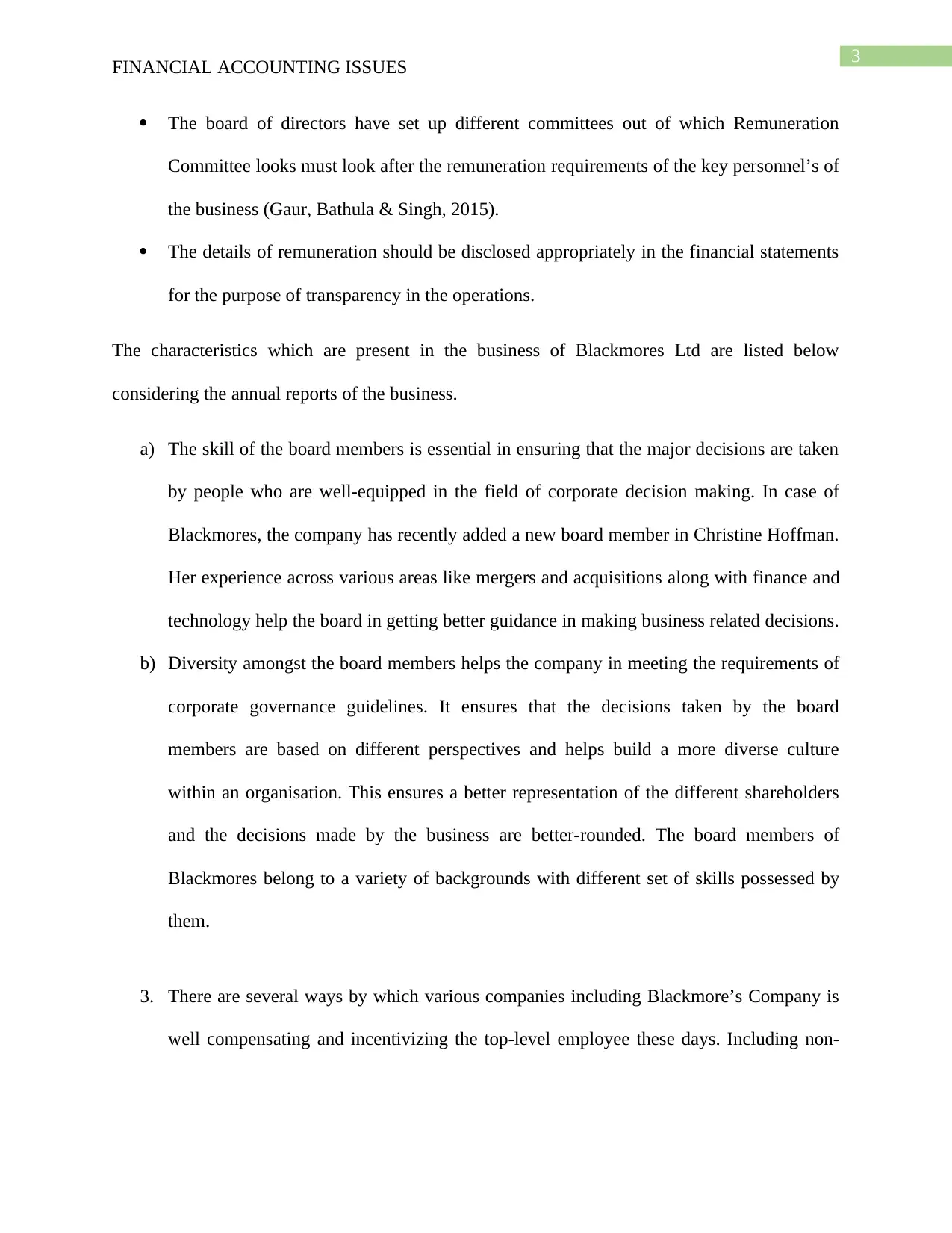
3
FINANCIAL ACCOUNTING ISSUES
The board of directors have set up different committees out of which Remuneration
Committee looks must look after the remuneration requirements of the key personnel’s of
the business (Gaur, Bathula & Singh, 2015).
The details of remuneration should be disclosed appropriately in the financial statements
for the purpose of transparency in the operations.
The characteristics which are present in the business of Blackmores Ltd are listed below
considering the annual reports of the business.
a) The skill of the board members is essential in ensuring that the major decisions are taken
by people who are well-equipped in the field of corporate decision making. In case of
Blackmores, the company has recently added a new board member in Christine Hoffman.
Her experience across various areas like mergers and acquisitions along with finance and
technology help the board in getting better guidance in making business related decisions.
b) Diversity amongst the board members helps the company in meeting the requirements of
corporate governance guidelines. It ensures that the decisions taken by the board
members are based on different perspectives and helps build a more diverse culture
within an organisation. This ensures a better representation of the different shareholders
and the decisions made by the business are better-rounded. The board members of
Blackmores belong to a variety of backgrounds with different set of skills possessed by
them.
3. There are several ways by which various companies including Blackmore’s Company is
well compensating and incentivizing the top-level employee these days. Including non-
FINANCIAL ACCOUNTING ISSUES
The board of directors have set up different committees out of which Remuneration
Committee looks must look after the remuneration requirements of the key personnel’s of
the business (Gaur, Bathula & Singh, 2015).
The details of remuneration should be disclosed appropriately in the financial statements
for the purpose of transparency in the operations.
The characteristics which are present in the business of Blackmores Ltd are listed below
considering the annual reports of the business.
a) The skill of the board members is essential in ensuring that the major decisions are taken
by people who are well-equipped in the field of corporate decision making. In case of
Blackmores, the company has recently added a new board member in Christine Hoffman.
Her experience across various areas like mergers and acquisitions along with finance and
technology help the board in getting better guidance in making business related decisions.
b) Diversity amongst the board members helps the company in meeting the requirements of
corporate governance guidelines. It ensures that the decisions taken by the board
members are based on different perspectives and helps build a more diverse culture
within an organisation. This ensures a better representation of the different shareholders
and the decisions made by the business are better-rounded. The board members of
Blackmores belong to a variety of backgrounds with different set of skills possessed by
them.
3. There are several ways by which various companies including Blackmore’s Company is
well compensating and incentivizing the top-level employee these days. Including non-
Paraphrase This Document
Need a fresh take? Get an instant paraphrase of this document with our AI Paraphraser
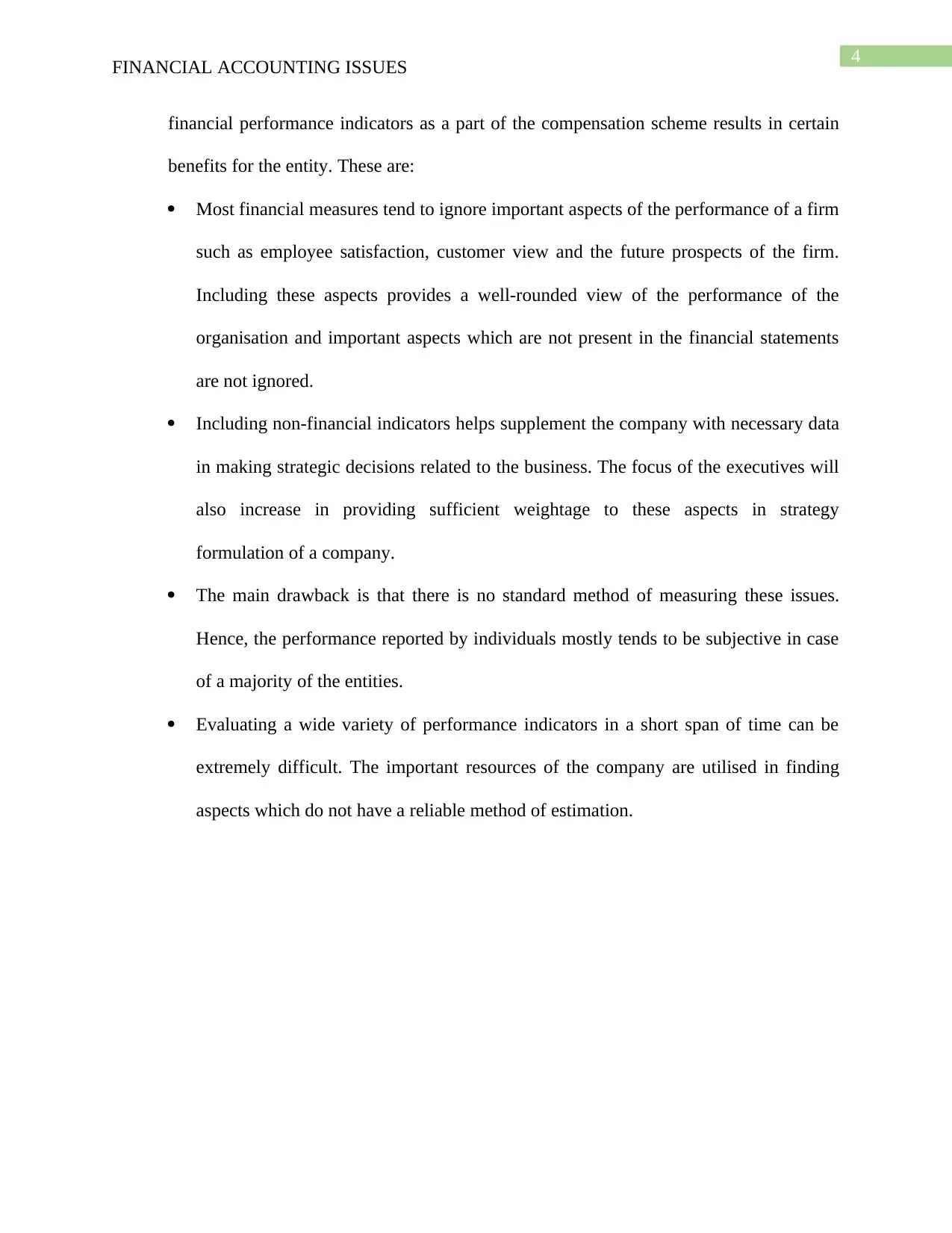
4
FINANCIAL ACCOUNTING ISSUES
financial performance indicators as a part of the compensation scheme results in certain
benefits for the entity. These are:
Most financial measures tend to ignore important aspects of the performance of a firm
such as employee satisfaction, customer view and the future prospects of the firm.
Including these aspects provides a well-rounded view of the performance of the
organisation and important aspects which are not present in the financial statements
are not ignored.
Including non-financial indicators helps supplement the company with necessary data
in making strategic decisions related to the business. The focus of the executives will
also increase in providing sufficient weightage to these aspects in strategy
formulation of a company.
The main drawback is that there is no standard method of measuring these issues.
Hence, the performance reported by individuals mostly tends to be subjective in case
of a majority of the entities.
Evaluating a wide variety of performance indicators in a short span of time can be
extremely difficult. The important resources of the company are utilised in finding
aspects which do not have a reliable method of estimation.
FINANCIAL ACCOUNTING ISSUES
financial performance indicators as a part of the compensation scheme results in certain
benefits for the entity. These are:
Most financial measures tend to ignore important aspects of the performance of a firm
such as employee satisfaction, customer view and the future prospects of the firm.
Including these aspects provides a well-rounded view of the performance of the
organisation and important aspects which are not present in the financial statements
are not ignored.
Including non-financial indicators helps supplement the company with necessary data
in making strategic decisions related to the business. The focus of the executives will
also increase in providing sufficient weightage to these aspects in strategy
formulation of a company.
The main drawback is that there is no standard method of measuring these issues.
Hence, the performance reported by individuals mostly tends to be subjective in case
of a majority of the entities.
Evaluating a wide variety of performance indicators in a short span of time can be
extremely difficult. The important resources of the company are utilised in finding
aspects which do not have a reliable method of estimation.
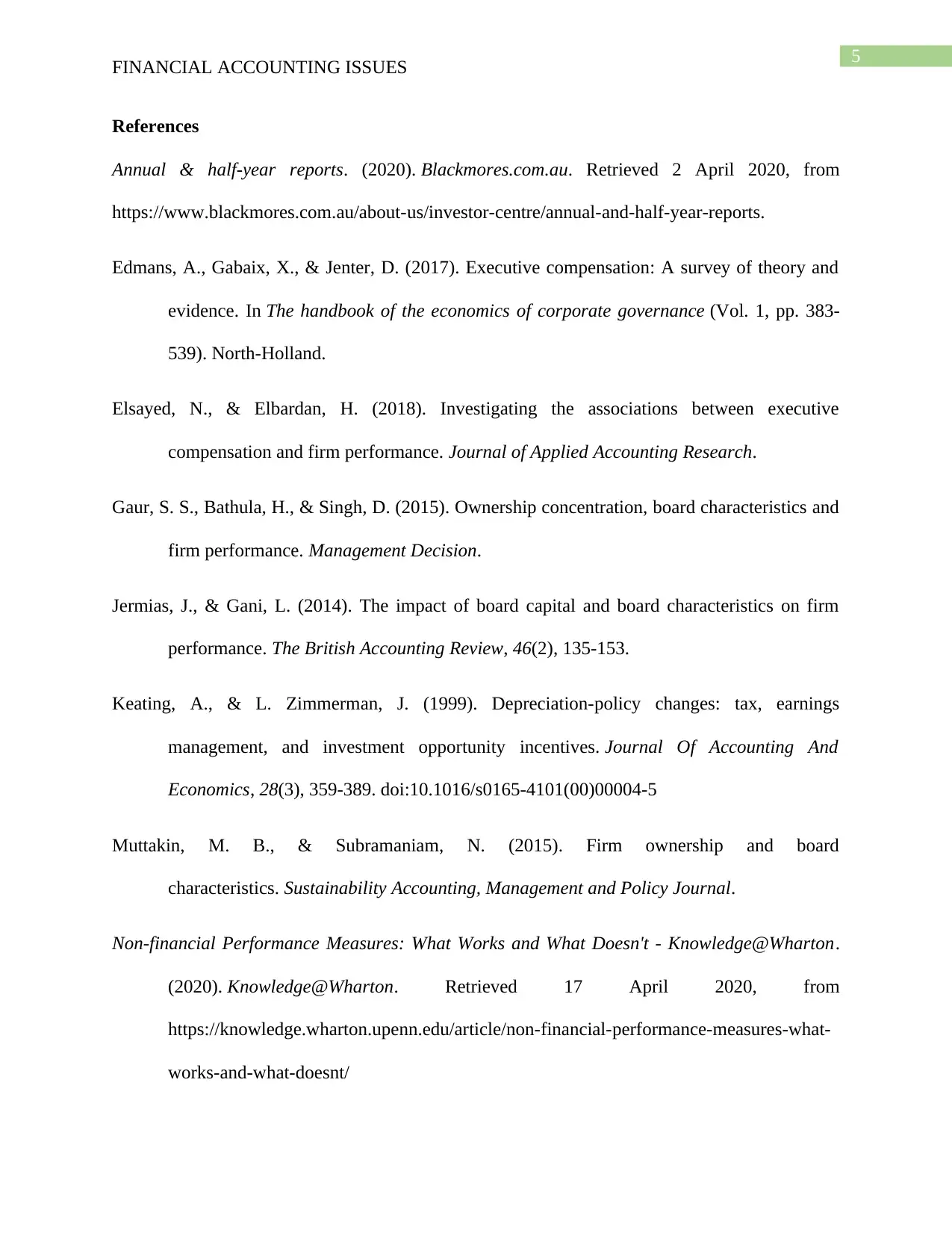
5
FINANCIAL ACCOUNTING ISSUES
References
Annual & half-year reports. (2020). Blackmores.com.au. Retrieved 2 April 2020, from
https://www.blackmores.com.au/about-us/investor-centre/annual-and-half-year-reports.
Edmans, A., Gabaix, X., & Jenter, D. (2017). Executive compensation: A survey of theory and
evidence. In The handbook of the economics of corporate governance (Vol. 1, pp. 383-
539). North-Holland.
Elsayed, N., & Elbardan, H. (2018). Investigating the associations between executive
compensation and firm performance. Journal of Applied Accounting Research.
Gaur, S. S., Bathula, H., & Singh, D. (2015). Ownership concentration, board characteristics and
firm performance. Management Decision.
Jermias, J., & Gani, L. (2014). The impact of board capital and board characteristics on firm
performance. The British Accounting Review, 46(2), 135-153.
Keating, A., & L. Zimmerman, J. (1999). Depreciation-policy changes: tax, earnings
management, and investment opportunity incentives. Journal Of Accounting And
Economics, 28(3), 359-389. doi:10.1016/s0165-4101(00)00004-5
Muttakin, M. B., & Subramaniam, N. (2015). Firm ownership and board
characteristics. Sustainability Accounting, Management and Policy Journal.
Non-financial Performance Measures: What Works and What Doesn't - Knowledge@Wharton.
(2020). Knowledge@Wharton. Retrieved 17 April 2020, from
https://knowledge.wharton.upenn.edu/article/non-financial-performance-measures-what-
works-and-what-doesnt/
FINANCIAL ACCOUNTING ISSUES
References
Annual & half-year reports. (2020). Blackmores.com.au. Retrieved 2 April 2020, from
https://www.blackmores.com.au/about-us/investor-centre/annual-and-half-year-reports.
Edmans, A., Gabaix, X., & Jenter, D. (2017). Executive compensation: A survey of theory and
evidence. In The handbook of the economics of corporate governance (Vol. 1, pp. 383-
539). North-Holland.
Elsayed, N., & Elbardan, H. (2018). Investigating the associations between executive
compensation and firm performance. Journal of Applied Accounting Research.
Gaur, S. S., Bathula, H., & Singh, D. (2015). Ownership concentration, board characteristics and
firm performance. Management Decision.
Jermias, J., & Gani, L. (2014). The impact of board capital and board characteristics on firm
performance. The British Accounting Review, 46(2), 135-153.
Keating, A., & L. Zimmerman, J. (1999). Depreciation-policy changes: tax, earnings
management, and investment opportunity incentives. Journal Of Accounting And
Economics, 28(3), 359-389. doi:10.1016/s0165-4101(00)00004-5
Muttakin, M. B., & Subramaniam, N. (2015). Firm ownership and board
characteristics. Sustainability Accounting, Management and Policy Journal.
Non-financial Performance Measures: What Works and What Doesn't - Knowledge@Wharton.
(2020). Knowledge@Wharton. Retrieved 17 April 2020, from
https://knowledge.wharton.upenn.edu/article/non-financial-performance-measures-what-
works-and-what-doesnt/
⊘ This is a preview!⊘
Do you want full access?
Subscribe today to unlock all pages.

Trusted by 1+ million students worldwide

6
FINANCIAL ACCOUNTING ISSUES
Sundvik, D. (2016). Earnings management around Swedish corporate income tax
reforms. International Journal of Accounting, Auditing and Performance
Evaluation, 12(3).
FINANCIAL ACCOUNTING ISSUES
Sundvik, D. (2016). Earnings management around Swedish corporate income tax
reforms. International Journal of Accounting, Auditing and Performance
Evaluation, 12(3).
1 out of 7
Related Documents
Your All-in-One AI-Powered Toolkit for Academic Success.
+13062052269
info@desklib.com
Available 24*7 on WhatsApp / Email
![[object Object]](/_next/static/media/star-bottom.7253800d.svg)
Unlock your academic potential
Copyright © 2020–2025 A2Z Services. All Rights Reserved. Developed and managed by ZUCOL.





